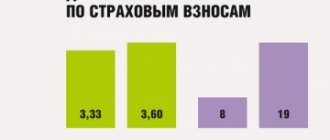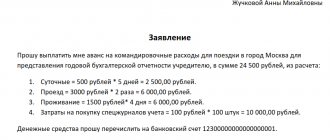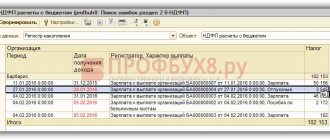Dates for excess daily allowance
To reflect the amount of excess daily allowance in form 6-NDFL, it is necessary to determine the dates that will be indicated in Section 2 of the Calculation.
The date of actual receipt of income for daily allowances subject to personal income tax is the last day of the month in which the advance report is approved after the employee returns from a business trip (clause 6, clause 1, article 223 of the Tax Code of the Russian Federation). Thus, this date must be indicated on line 100 “Date of actual receipt of income” of form 6-NDFL.
The date of tax withholding (line 110) will be the date of actual payment of income from which personal income tax was withheld (clause 4 of Article 226 of the Tax Code of the Russian Federation). It is important to keep in mind that this date cannot be earlier than the last day of the month, because personal income tax cannot be withheld if income is not received. And since the income was received on the last day of the month, then personal income tax can be withheld at the next payment of income made on the last day of the month or later (Letter of the Federal Tax Service dated April 29, 2016 No. BS-4-11/7893).
Accordingly, personal income tax on excess daily allowances must be transferred no later than the business day following the day when personal income tax was withheld from daily allowances.
The company pays per diem more than the limit
The company established the daily allowance amount internally. For each day of a business trip in Russia, the company pays more than 700 rubles, abroad - more than 2,500 rubles.
Daily allowances are exempt from personal income tax within the limit: 700 rubles for each day of a business trip in Russia and 2,500 rubles when traveling abroad (clause 3 of article 217 of the Tax Code of the Russian Federation). Do not include daily allowance within the limit in the calculation. If the company issues more, in sections 1 and 2 of the calculation, write down only the amount that exceeds the limit.
The date of receipt of income in the form of daily allowance is the last day of the month in which the head of the company approved the advance report. The date of issue of the daily allowance does not matter. On the last day of the month, calculate personal income tax on the excess daily allowance.
The company withheld personal income tax during the quarter. Reflect the daily allowance in sections 1 and 2 of the calculation. In line 020, write down the daily allowance over the limit. In line 040 - personal income tax from them, in line 070 - the amount withheld. In line 100 of section 2, enter the date of receipt of income - the last day of the month. In line 110 - the date when the company was able to withhold personal income tax, in line 120 - the next business day.
The company withheld personal income tax in the next quarter. In the quarter in which the company accrues income and tax, show the amounts above the limit in section 1. In line 020 - income, in line 040 - calculated personal income tax.
Withhold personal income tax calculated from daily allowances from your next cash income. You can withhold no more than 50 percent of income (clause 4 of article 226 of the Tax Code of the Russian Federation). During the period when the company withholds personal income tax, reflect the payment in line 070 of section 1 (letter of the Federal Tax Service of Russia dated May 16, 2016 No. BS-4-11/8609).
In any case, fill out Section 2 only in the reporting for the period in which personal income tax was withheld. In line 100, write down the last day of the month in which the manager approved the expense report. In line 110 - the date of payment of income from which the company was able to withhold personal income tax. Line 120 shows the next business day.
For example
The company issues a daily allowance of 1,000 rubles for each day of a business trip. In March, the employee went on a business trip for 10 days. The company gave the employee 10,000 rubles. (RUB 1,000 × 10 days). The manager approved the advance report on March 28. The date of receipt of income in the form of excess daily allowance is 03/31/2016. On this date, the company accrued income of 3,000 rubles. (10,000 rubles - 700 rubles × 10 days). And I calculated personal income tax - 390 rubles.
(RUB 3,000 × 13%). 3000 rub. the company included in line 020 of the calculation for the first quarter, and 390 rubles. - in line 040.
The company withheld personal income tax from the salary for March, which was issued on April 5. The company included the tax on daily allowance in line 070 in the calculation for the half-year. The company filled out Section 2 on over-limit daily allowances only for half a year. The date of receipt of income from salary and excess daily allowance is the same - 03/31/2016, so the company combined payments and reflected lines 100–140 in one block. Salary for March - 50,000 rubles, personal income tax - 6,500 rubles. (RUB 50,000 × 13%). The employee’s total income as of March 31, 2016 is RUB 53,000. (50,000 + 3,000). Personal income tax - 6,890 rubles. (390 + 6,500). The company filled out the calculation as in sample 50.
Sample 50. How to fill out the daily allowance in excess of the limit in section 2:
Top
Letter of the Ministry of Finance of the Russian Federation No. 03-04-06/36099 dated June 21, 2016
The Department of Tax and Customs Policy reviewed the LLC’s letter on the issue of determining the taxable base for personal income tax when sending employees on business trips and, in accordance with Article 34.2 of the Tax Code of the Russian Federation (hereinafter referred to as the Code), explains the following.
In accordance with paragraph 3 of Article 217 of the Code, when an employer pays a taxpayer expenses for business trips both within the country and abroad, the income subject to taxation does not include daily allowances paid in accordance with the legislation of the Russian Federation, but not more than 700 rubles for each day while on a business trip in the Russian Federation and no more than 2,500 rubles for each day of being on a business trip abroad.
Amounts of daily allowance paid to an employee in excess of the amounts established by paragraph 3 of Article 217 of the Code are subject to personal income tax.
In accordance with subparagraph 6 of paragraph 1 of Article 223 of the Code, the date of actual receipt of personal income tax income is defined as the last day of the month in which the advance report is approved after the employee returns from a business trip.
The determination of income subject to taxation, taking into account the provisions of paragraph 3 of Article 217 of the Code, is made by the tax agent organization on the last day of the month in which the advance report is approved after the employee returns from a business trip, and the calculation of tax amounts is carried out by tax agents in accordance with paragraph 3 of Article 226 of the Code on the date of actual receipt of income.
Excess daily allowance in 6-NDFL: example
For July 2021, the employee received a salary (including average earnings during the business trip) in the amount of 76,000 rubles, incl. Personal income tax 13% - 9,880 rubles. The advance for July was paid on July 15, 2016 in the amount of 30,000 rubles. On July 27, 2016, the employee submitted an advance report for a business trip on the territory of the Russian Federation, which indicated the daily allowance for 4 days of the business trip in the amount of 4,000 rubles. (4 days * 1000 rub./day). On July 28, 2016, the advance report was approved by the General Director. On 08/05/2016, the employee was paid the balance of his salary for July 2021, taking into account the withholding of personal income tax from the salary of 9,880 rubles, as well as personal income tax from the excess daily allowance of 156 rubles. ((4,000 rub. – 4 days * 700 rub./day)*13%). The final payment was 35,964 rubles. (RUB 76,000 – RUB 30,000 – RUB 9,880 – RUB 156). Personal income tax was transferred to the budget on time (08/08/2016). There were no other payments in the reporting period.
Section 2 of form 6-NDFL for 9 months of 2021 will be filled out as follows:
- line 100 “Date of actual receipt of income” - 07/31/2016;
- line 110 “Tax withholding date” - 08/05/2016;
- line 120 “Tax payment deadline” - 08/08/2016;
- line 130 “Amount of income actually received” - 77,200 (76,000 + (4,000 – 700*4));
- line 140 “Amount of tax withheld” - 10,036 (9,880 + 156).
Please note that the indicators for wages and excess daily allowance in Section 2 are collapsed, since all dates in lines 100-120 of Section 2 in relation to these payments coincided.
> How to correctly reflect daily allowances in excess of the norm in 6-NDFL?
We reflect daily allowances in 6-NDFL
Daily allowances above the norm in 6-NDFL: examples
Results
Taxation of daily allowances in 2018
Those. The program behaves quite adequately to the legislation.
With this approach, everything is in order with the accounts: We take personal income tax from the salary in the usual normal way, only this month more, because we take into account additional income.
By Oleg Perov / July 23rd, 2021 / Civil law / No Comments
Daily allowances in excess of the 6-NDFL norm (hereinafter referred to as the calculation) are included in accrued income only in the amount of their excess over the limit. Read our article about how to show excess daily allowances in the main calculation lines.
We reflect daily allowances in 6-NDFL
Daily allowances above the norm in 6-NDFL: examples
Results
We reflect daily allowances in 6-NDFL
Clause 3 Art. 217 of the Tax Code of the Russian Federation states that there is a limit for daily allowances, from which personal income tax is not paid. This is 700 rubles. per day for business trips around the country and 2,500 rubles. per day for foreign business trips. If, according to internal regulations, the employer issues large amounts of daily allowance, then everything issued in excess of the limit is subject to personal income tax. Accordingly, taxable income must be reflected in 6-NDFL.
Read more about the rules for paying daily allowances.
We show the amount of income on line 020 only to the extent of the excess. The option in which the full amount of income is shown on line 020 and a deduction for the amount of the limit on line 030 is not suitable, since in the letter of the Federal Tax Service dated 08/01/2016 No. BS-4-11/13984 (question 3) it is explained that in line 030 amounts fall in accordance with the codes of the types of deductions listed in the Federal Tax Service order dated September 10, 2015 No. ММВ-7-11/ [email protected]
The date of receipt of income (p. 100) in the form of daily allowance is recognized as the last day of the month when the manager approves the advance report (subclause 6, clause 1, article 223 of the Tax Code of the Russian Federation). This date cannot be the day the money is issued, since at that moment there is still no supporting document, the accomplished fact of the business trip, and the employee receives an advance, which can be returned in case of early arrival back or cancellation of the trip.
The employer must withhold tax (p. 110) when the next payment of funds to the employee occurs after the date of receipt of income (clause 4 of Article 226 of the Tax Code of the Russian Federation). The Federal Tax Service does not allow tax to be withheld before this date (letter from the Federal Tax Service dated July 25, 2014 No. BS-4-11/ [email protected] ).
As a rule, personal income tax on excess daily allowances is withheld on the day the salary is issued for the month in which the advance report is approved. The tax transfer (page 120) is made the next day after the withholding (clause 6 of Article 226 of the Tax Code of the Russian Federation).
See also “How is a one-day business trip paid?”
Answer
Indicate the date of actual receipt of income for travel expenses as the last day of the month in which the advance report was approved.
This rule is established by subparagraph 6 of paragraph 1 of Article 223 of the Tax Code.
On line 100 of section 2 of the 6-NDFL calculation, indicate - 01/31/2018.
Rationale How to draw up and submit a calculation using Form 6-NDFL
Situation: how to reflect income that is not taxed within the established standards in the calculation of 6-NDFL
The answer to this question depends on the type of standardized income.
Gifts, prizes, financial assistance
Daily allowances, compensation and other similar income
For personal income tax purposes, daily allowances also fall into the category of standardized expenses (clause 3 of Article 217 of the Tax Code). However, the maximum amount of daily allowance exempt from taxation should be determined not on an accrual basis from the beginning of the year, but on each payment. In this case, the date of actual receipt of income in the form of daily allowances is the last day of the month in which the employee’s advance report on the business trip was approved (subclause 6, clause 1, article 223 of the Tax Code).
In the calculation of 6-NDFL, reflect only the excess portion of the daily allowance. Do not include daily allowances within the standards in the calculation.
For example, in nine months, an employee of the organization went on business trips across Russia twice: - in July. The duration of the business trip is three days. Daily allowances were paid at the rate of 1200 rubles. per day for a total of 3,600 rubles. The advance report was approved on July 25; - in August. The duration of the business trip is three days. Daily allowance was paid at the rate of 1100 rubles. per day for a total of 3,300 rubles. The advance report was approved on August 28.
The daily allowance rate for personal income tax purposes is 700 rubles. in a day. The amount of excess daily allowance was: – for July – 1500 rubles. ((1200 rub. – 700 rub.) × 3 days). Personal income tax amount – 195 rubles; – for August – 1200 rub. ((1100 rub. – 700 rub.) × 3 days). Personal income tax amount – 156 rubles.
The dates of actual receipt of income are July 31 and August 31, respectively. The accountant withholds personal income tax from the nearest cash payments - August 3 and September 5.
In calculating 6-NDFL for nine months, the accountant reflected the excess daily allowance and the tax withheld from it as follows:
– on line 020 – 2700 rubles; – on line 040 – 351 rubles; – on line 070 – 351 rubles;
– on line 100 – 07/31/2018; – on line 110 – 08/03/2018; – on line 120 – 08/06/2018; – on line 130 – 1500 rubles; – line 140 – 195 rubles;
– on line 100 – 08/31/2018; – on line 110 – 09/05/2018; – on line 120 – 09/06/2018; – on line 130 – 1200 rubles; – on line 140 – 156 rubles.
The same procedure applies to other income, which is normalized with each payment.
Section 2 indicates the dates of receipt and withholding of tax, the deadline set for transferring tax to the budget, as well as the amount of income actually received and withheld personal income tax. To correctly fill out section 2, all income will have to be grouped: – by the dates when they were actually paid; - according to the timing when the personal income tax amounts withheld from these incomes must be transferred to the budget.
That is, for each date of actual payment, indicate a separate tax amount. And if on the same day you paid income for which different deadlines for paying personal income tax were established, then these amounts must also be indicated separately. This is stated in the letters of the Federal Tax Service dated May 11, 2016 No. BS-4-11/8312 and dated March 18, 2016 No. BS-4-11/4538.
When filling out section 2, indicate all transactions in chronological order. There is no need to group them according to the tax rates specified in section 1. If the page runs out of free lines 100–140, go to the next page. It doesn't matter that it may start from section 1 for a different tax rate. Continue making transactions in a row. If there are more pages with completed sections 1 than are needed to fill out section 2, then put dashes in the empty lines 100–140. Such clarifications are in the letter of the Federal Tax Service dated April 27, 2016 No. BS-4-11/7663.
In section 2, include only those transactions that relate to the last three months of the reporting period (letter of the Federal Tax Service dated February 18, 2016 No. BS-3-11/650). In this case, focus on the date no later than which personal income tax must be transferred to the budget. That is, reflect the income paid and the tax withheld in the reporting period in which the deadline for paying personal income tax falls. It doesn't matter when you actually paid the income, withheld and remitted the tax. For example, in section 2 of the calculation for nine months, you need to reflect data on the payment of income (tax withholding), for which the deadline for paying personal income tax falls for the period from July 1 to September 30 inclusive. Such clarifications are given in the letter of the Federal Tax Service dated October 24, 2016 No. BS-4-11/20126.
Please complete Section 2 in this order.1
on line 100 – the date of actual receipt of income. For example, for income in the form of wages - this is the last day of the month for which the salary was accrued, and for remuneration under civil contracts - the day the remuneration is paid,
on line 110 – tax withholding dates;
on line 120 – dates no later than which the tax must be transferred to the budget. Indicate these dates in accordance with paragraph 6 of Article 226 and paragraph 9 of Article 226.1 of the Tax Code (letter of the Federal Tax Service dated January 20, 2016 No. BS-4-11/546). As a rule, this is the day following the day the income is paid. But, for example, for sick leave and vacation pay, the deadline for transferring tax to the budget is different: the last day of the month in which such payments were made. If the established deadline for tax transfer falls on a weekend, in line 120 indicate the next working day (clause 7, article 6.1 of the Tax Code, letter of the Federal Tax Service dated May 16, 2016 No. BS-4-11/8568);
on line 130 – the amount of income (including personal income tax) received as of the date that the tax agent indicated on each line 100;
on line 140 – the amount of tax that the agent withheld as of the date on each line 110.
This is stated in paragraphs 4.1–4.2 of the Procedure approved by Order of the Federal Tax Service dated October 14, 2015 No. ММВ-7-11/450.
Sometimes it is difficult to foresee all the expenses associated with a business trip. Therefore, organizations usually provide additional funds to employees performing assignments. You will learn how to reflect excess daily allowances in 6-personal income tax from our consultation.
Daily allowances above the norm in 6-NDFL: examples
Let's consider various situations of drawing up calculations with excess daily allowances.
- Is it possible to withhold personal income tax after the advance report is approved, but until the end of the month?
Example
The employee was on a business trip within the country for 5 days, from March 1 to March 5, 2021. On February 28, he received an advance payment for the trip, including a daily allowance of 1,300 rubles. per day, total 6,500 rubles. The amount of daily allowance above the norm was (1,300 – 700) × 5 = 3,000 rubles. On March 7, the employee submitted the advance report for approval. On March 20, the company paid an advance on wages, the final payment of wages was made on April 5.
In the calculation for 6 months of 2021, daily allowances are included as follows:
| Line number | Meaning |
| 3 000 | |
| 08.04.2019* | |
| 3 000 |
* The tax payment deadline is the day following the date of payment of income, i.e. 04/06/2019. But since this is a weekend, the deadline is shifted to the next closest working date: 04/08/2019.
It is impossible to withhold tax on March 20, since this date precedes 03/31/2019.
- Is it possible to withhold personal income tax after the end of the month, but not when paying wages?
Example
The employee was on a business trip within the country for 5 days, from March 1 to March 5, 2021. On February 28, he received an advance payment for the trip, including a daily allowance of 1,300 rubles. per day, total 6,500 rubles. The amount of daily allowance above the norm was (1,300 – 700) × 5 = 3,000 rubles. On March 7, he submitted the advance report for approval. On March 20, the company paid an advance on wages, the final payment of wages was made on April 5. On April 1, this employee was paid vacation pay.
In the calculation for 6 months of 2021, daily allowances are included as follows:
| Line number | Meaning |
| 3 000 | |
| 3 000 |
Personal income tax can be withheld for any payment following the last day of the month of approval of the advance report.
- What to do if the daily allowance was paid after a business trip?
Example
The employee went on a business trip to another country without having time to take an advance payment. I stayed there for 5 days, from March 1 to March 5, 2021. On August 7, he submitted the advance report for approval. According to the report, in addition to compensation for other expenses, the employee is entitled to a daily allowance of 3,000 per day. The amount of daily allowance above the norm was (3,000 – 2,500) × 5 = 2,500 rubles. On March 11, the employee received full reimbursement for travel expenses. The final payment of wages was made on April 5.
In the calculation for 6 months of 2021, daily allowances are included as follows:
| Line number | Meaning |
| 2 500 | |
| 2 500 |
Despite the fact that the daily allowance was paid after the approval of the advance report, personal income tax cannot be withheld from this payment, since the income is considered received later - 03/31/2019.
Reflection of daily allowances in the calculation of 6-NDFL in 2019
The time that an employee spends on a business trip (work trip) in accordance with the issued order of the employer is recognized as working time. For these days, the posted worker is paid an average salary, and expenses related to the trip are also compensated.
The period of stay on a business trip (for daily allowances) is calculated by calendar days. It also includes: days of departure and arrival, travel. If these days fall on a weekend, then he can be considered a worker only at the initiative of the employer. Then the daily allowance (or travel allowance) is paid for that day as well. One of the following options may apply to the average daily earnings due:
- The business traveler receives an additional paid day off.
- Or he is paid double his average daily wage.
Both the first and second options are agreed upon with the employer. Expenses for business trips of an individual entrepreneur who works alone, without staff, are not compensated, since he himself is an employer.
For accounting purposes, expenses for business trips are documented in an advance report. At the same time, the accounting department takes into account all expenses that the employer decides to reimburse. Moreover, there may not be documentary evidence here.
Travel allowances are considered expenses for ordinary activities. They are accepted for accounting on the date of signing (approval) of the advance report by the employer.
Above-limit travel allowances, personal income tax and general mandatory contributions for 2021.
The employer has the right to send an employee on a business trip in Russia or abroad. The business traveler is compensated daily for travel expenses. The date of payment of daily allowances is the day they are accrued. The day of approval of the business trip report is the date of receipt of income (in the form of daily allowance).
In 2021, a fixed limit on daily expenses has been determined, from which general mandatory insurance and personal income tax contributions are not calculated (Read also the article: → “Deadlines for submitting reports on 6-personal income tax in 2021”).
| Type of business trip | Legal limit on travel expenses for one day |
| Business trip to Russia | 700 rub. |
| Business trip abroad, outside the Russian Federation | 2,500 rub. |
The tax-free limit on contributions is established at a time; it cannot be determined on a cumulative basis. An organization has the right to prescribe in local regulations its daily allowance for business trips within the Russian Federation and beyond its borders. Moreover, it can exceed a fixed limit. Such daily allowances are called excess (i.e., above the established norm, limit). The amount exceeded by law will be subject to personal income tax and contributions for compulsory insurance (in addition to the injury tax) in the generally accepted manner.
This innovation has been in effect since 2021. Previously, travel expenses were not subject to general mandatory contributions if the limits were specified in the organization’s local acts.
So, from 2021, excess travel expenses are subject to personal income tax and mandatory insurance contributions, regardless of whether the excess amounts are fixed in the internal regulations of the organization or not.
Personal income tax is calculated on the final day of the month in which the business trip report was agreed upon. The tax is withheld after this date on the first payment, mainly from salary. It can be transferred to the budget on the day the income is paid or the day after that, but not later.
Uniform requirements for registration of 6-NDFL
This is a standard reporting form according to which a tax agent (individual entrepreneur, organization) reports for the income of its personnel. The document has been introduced and applied since 2021. Its structure consists of a title page and 2 sections. This type of reporting is generated on an accrual basis for the first quarter, six months, 9 and 12 months.
Entries are made based on available information on income, deductions, and personal income tax. The tax agent must enter the information. He also submits the completed document to the Federal Tax Service.
The rules for filling out this form are determined and formalized by the Federal Tax Service of the Russian Federation. Amounts and details are required to be filled out. If there are not enough pages for the information that needs to be entered, then the required number of pages is taken to fill out. In familiar places that are not filled in, dashes are added.
The form can be filled out on a computer and printed. Then dashes are not placed in empty positions. The font used is Courier New 1 (6-18 points).
The date is written on each completed page and the signature of the head of the organization (individual entrepreneur, notary, lawyer, representative of the tax agent) is affixed.
The procedure for displaying above-limit travel expenses in 6-NDFL
In order to display excess amounts, Section 2 of 6-NDFL is drawn up. Here the dates and amounts of income and personal income tax are specified. The section includes 5 lines.
| Key points of section 2 line by line | Section 2 details (what does it include?) |
| Page “100” (Date of actual receipt of income) | This refers to income, the size of which is displayed at position “130”; the last day of the month is written (Article 223 of the Tax Code of the Russian Federation); sickness benefits and vacation pay are recorded on the actual date of receipt |
| Page “110” (Dating of withheld personal income tax) | Income tax is withheld on the day the actual income is received (displayed in position “130”), and it is from this that the tax is calculated |
| Page “120” (Date of income transfer) | The duration is influenced by the type of income: sickness benefits and vacation pay are issued before the end of the month; in some cases, the information is reflected the next day after receiving the money. Usually the date is recorded here, no later than which personal income tax is deducted |
| Page “130” (Amount of income received) | This includes: the exact amount of total actual income without deduction of withholding tax; amount of excess travel allowances |
| Page “140” (Value of withheld personal income tax) | The summed personal income tax that was withheld on the date recorded in position “110” |
If the beginning of an operation belongs to one reporting period, and the end to another, then section 2 of this form records information on the final period.
Example 1. Display and calculation of excess travel expenses, income tax, income in 6-NDFL
An employee of Proekt LLC, Tsarev N.M., was on a three-day business trip (July 2021) around the Russian Federation. His daily allowance for 3 days amounted to 3,000 rubles. (1,000 rubles for each business trip day). The advance report that the traveler submitted to the director was approved on July 28, 2017.
The accrued July salary of N. M. Tsarev amounted to 70,000 rubles. So, for July 2021 he was paid:
- 07.2017 - advance payment towards pay 35,000 rubles;
- 08.2017 - the balance of July earnings, taking into account the withheld income tax on it and on travel expenses.
The calculated tax was received by the budget on August 4, 2017. Daily travel allowances issued to an employee (1,000 rubles) exceed the fixed limit, i.e. 700 rubles. This means that personal income tax must be withheld from the difference, i.e., the amount exceeding the limit. Accordingly, this fact should be reflected in 6-NDFL (section 2, for 9 months).
| Calculation of amounts for pay, personal income tax and travel allowances | Line-by-line display of above-limit travel allowances issued to Tsarev N.M. (6-NDFL, section 2) |
| The total amount of travel allowances issued to N.M. Tsarev for 3 days of the business trip: 1,000 * 3 = 3,000 rubles. Amount of daily allowance for 3 days of a business trip, from which, by law, personal income tax does not need to be calculated: 700 rubles. per day * 3 days = 2,100 rub. The amount of daily allowance exceeding the limit is withheld from personal income tax (13%): 3,000 – 2,100 = 900 rubles. Personal income tax withheld from the excess amount of daily allowance: 900 rubles. * 13% = 117 Personal income tax on earnings: 70,000 * 13% = 9,100 rubles. Actual earnings received by N. M. Tsarev for July: 70,000 rubles. + 900 rub. = 70,900 rub. The summed personal income tax from pay and the excess amount of daily allowance: 117 + 9,100 = 9,217 rubles. | Page “100” (Date of receipt of income) - 07/31/2017 Page “110” (Dating of personal income tax withholding) - 08/3/2017 Page “120” (Dating of personal income tax enrollment) - 08/04/2017 Page “130” (Amount of actual salary of Tsarev N.M.) - 70,900 rubles. Page “140” (Total amount of personal income tax withheld) - 9,217 rubles. |
Reflection Examples
How to reflect excess daily allowance in 6-NDFL? Line 020 shows only the excess amount. The date when income was received in the form of daily payments is indicated in line 100. It is considered the last day of the month on which the manager approved the advance report. However, this is not necessarily the date the employee receives the payment, since he may return from a business trip before the deadline.
The employer must withhold tax immediately after the employee receives the income. According to the requirements of the Federal Tax Service, this cannot be done earlier. In practice, what happens is that tax is withheld on the day the employee’s salary was issued, and taxes are transferred the next day.
Insurance premiums
The concept of insurance premiums does not apply to daily allowances that correspond to the specified amounts. In order to avoid the emergence of any conflicts and uncertain situations, the organization must specify in a certain statutory document the principle by which daily allowances are calculated.
Insurance premiums are calculated on daily allowances exceeding the established standard. One-day business trips cannot fall under this category under any circumstances.
If you take a closer look at one-day business trips, you will find that opinions on them are very mixed.
Thus, the Social Insurance Fund believes that daily allowances should be paid in all cases. The opinion of the Supreme Arbitration Court is exactly the opposite. It is based on the fact that payments received by an employee during a business trip do not act as his additional income. They only compensate him for the inconvenience caused by the employer’s instructions.
Features of filling out the form
An example of filling out a report in Form 6-NDFL can be found on the website of the Federal Tax Service. It is sent there every reporting period, that is, quarter.
The calculation includes a title page and two sections. The first section is called “Generalized Indicators”, and the second section indicates the dates and amount of income received and tax withheld. The document must be completely filled out.
How to fill out the title page?
At the top of the first sheet is the individual taxpayer number and the company checkpoint. If the form is submitted to a separate department, then you need to indicate its checkpoint too. When filling out the line with the company’s TIN, the last two cells are usually crossed out. Individual entrepreneurs, notaries, and lawyers register only a personal TIN.
Sick leave in 6-NDFL is reflected along with all amounts that were allocated to the employee.
Read how salary is reflected in parts in 6-NDFL.
In the line called “Adjustment number” enter 000, if the primary calculation is submitted, if corrected, then the serial number of the corrections is indicated, for example, 001 or 002.
In the “Reporting period” line you need to enter the code:
| 21 | If the calculation is submitted for the first quarter. |
| 31 | If the calculation is submitted for half a year. |
| 33 | If the payment is due 9 months in advance. |
| 34 | If the calculation is submitted for a calendar year. |
In the column called “New period” the reporting year is indicated, for example, 2021. Next, you need to write the code of the tax service where the calculation is sent, on the appropriate date.
And then enter a special three-digit code, which changes depending on the location or registration:
| 120 | At the place of residence of the individual entrepreneur. |
| 125 | At the lawyer's place of residence. |
| 126 | At the notary's place of residence. |
| 212 | In the place where the Russian company is registered. |
| 213 | In the place where a large taxpayer is registered. |
| 220 | In the place where a separate division of a domestic company is located. |
| 320 | In the place where the entrepreneur operates on UTII. |
| 335 | In the place where a separate division of a foreign company is located. |
The short name of the organization, which is established by the constituent document, is indicated in the line “Tax Agent”; if it is not available, then the full name is written.
How to fill out section 1?
The first section is usually filled in with a cumulative total. If there are several tax rates, then they are all indicated in separate sections.
Lines 060-090 should be filled in only once:
| Line 010 | The tax rate is indicated. |
| 020 | The amount of employee income during the reporting year is reflected. |
| 025 | Additional bonus income is allocated. |
| 030 | The total amount of all deductions made from all employees is shown; taxable income is reduced by exactly this amount. The line is also filled in for the entire period. |
| 040 | The amount of calculated tax during the year is reflected; To do this, it is necessary to add up the personal income tax indicators that were withheld from the income of employees. |
| 045 | It is filled out in the same way, but only dividends are taken into account. |
| 050 | Advance payments are recorded, offset against the income tax of foreign citizens who work under a patent. |
| 060 | The number of employees who received wages during the reporting period is indicated. |
| 070 | The amount of tax withheld is indicated. |
The amount in lines 040 and 070 may not match. This situation may arise if the employee’s income was indicated and tax was calculated on him, but the actual payment was not made. The Federal Tax Service decided that line 070 will only include the tax that was withheld at the time of reporting.
| Line 080 | The calculated personal income tax amount is indicated. |
| 090 | The amount of tax that was refunded under Article 231 of the Tax Code of the Russian Federation is indicated. Article 231. Procedure for collection and refund of tax |
How to fill out section 2?
This section describes only those actions that were carried out during the last three months of the reporting period:
| Line 100 | The dates of actual receipt of wages are indicated. |
| 110 | The dates when the tax was withheld are indicated. |
| 120 | The date when the tax should be transferred is written, usually the next business day after receiving wages. |
| 130 | The amount of income received as of the date indicated in line 100 is displayed. |
| 140 | The amount withheld at the time of date is indicated in line 110. |







